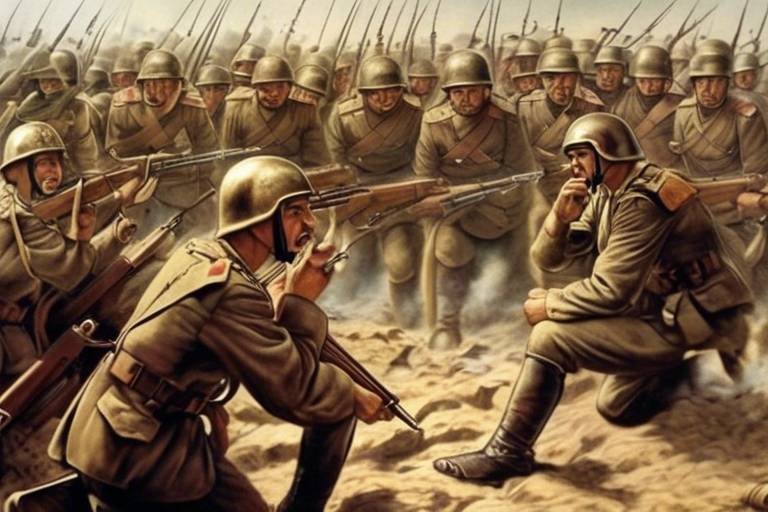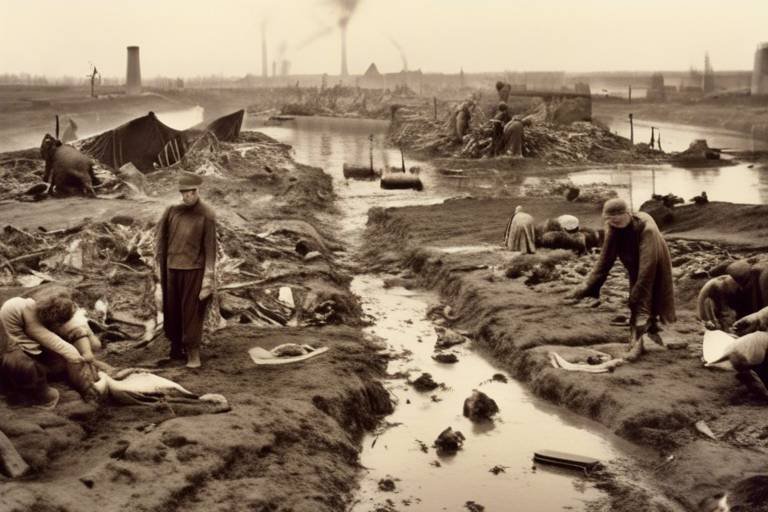The Role of Military Strategies in World History
Throughout history, military strategies have played a crucial role in shaping the course of events and civilizations worldwide. From ancient battles to modern warfare, the tactics employed by military leaders have had a profound impact on the outcomes of conflicts and the development of societies.
Ancient civilizations such as the Romans, Greeks, and Egyptians were pioneers in the art of war, utilizing innovative strategies, formations, and tactics to secure victories on the battlefield. Their military prowess and strategic thinking laid the foundation for future generations of military leaders to build upon.
As history progressed into the medieval period, warfare evolved, leading to the development of siege tactics, castle defenses, and the rise of knights and cavalry as formidable forces on the battlefield. The strategic importance of strongholds and fortifications became evident, shaping the way wars were fought and won.
During the age of colonialism, military strategies played a pivotal role in the expansion of empires through naval power, exploration, and conquest. The British, Spanish, and Portuguese empires utilized their military might to establish dominance over vast territories, reshaping the geopolitical landscape of the world.
The world wars of the 20th century introduced new levels of destruction and innovation in military strategies. From trench warfare in World War I to blitzkrieg tactics in World War II, the use of air power and technological advancements revolutionized the way wars were fought, leaving a lasting impact on global history.
The Cold War era brought about a new form of military strategy focused on nuclear deterrence, espionage, and proxy wars between superpowers. The threat of mutually assured destruction shaped the geopolitical dynamics of the time, leading to a tense standoff between rival nations.
In more recent times, guerrilla warfare and insurgencies have emerged as effective tactics in asymmetric conflicts, challenging conventional military strategies and posing new challenges for modern armies. From the jungles of Vietnam to the mountains of Afghanistan, guerrilla fighters have proven their resilience and adaptability on the battlefield.
The advent of cyber warfare and information operations has further transformed the landscape of military strategies in the 21st century. Hacking, disinformation campaigns, and the use of technology in warfare have become increasingly prevalent, blurring the lines between physical and virtual battlegrounds.
Looking ahead, the future of military strategies is poised to be shaped by artificial intelligence, drone warfare, space militarization, and the ever-evolving nature of warfare in the digital age. As technology continues to advance, military leaders must adapt and innovate to stay ahead in an increasingly complex and interconnected world.

Ancient Military Tactics
Ancient military tactics played a crucial role in shaping the course of history, with civilizations like the Romans, Greeks, and Egyptians employing innovative strategies in warfare. The Romans, known for their disciplined legions and strategic formations, utilized tactics such as the famous "testudo" formation to protect soldiers from projectiles. Meanwhile, the Greeks, masters of phalanx warfare, leveraged the strength of their hoplite soldiers in tight formations to create impenetrable walls of shields and spears. The Egyptians, with their chariots and archery prowess, focused on swift maneuvers and ranged attacks to outmaneuver their enemies.
Moreover, ancient military tactics were not just about brute force but also about intelligence and deception. Spies and scouts were used to gather vital information about enemy movements, strengths, and weaknesses. Ambushes and surprise attacks were common strategies employed to gain the upper hand in battles. The use of siege warfare, such as the famous siege of Troy, showcased the importance of strategy and patience in overcoming fortified defenses.
Additionally, the development of innovative weapons and armor, such as the Roman gladius and lorica segmentata, the Greek phalanx shield and Corinthian helmet, and the Egyptian composite bow, revolutionized warfare during ancient times. These advancements in military technology not only influenced the outcome of battles but also impacted the evolution of military strategies for centuries to come.

Medieval Warfare and Sieges
During the medieval period, warfare was characterized by the use of intricate military strategies that shaped the course of history. One of the key developments in this era was the evolution of siege warfare, where armies laid siege to fortifications in order to conquer territories. Castles played a crucial role in medieval warfare, serving as strongholds that required specialized tactics to breach their defenses.
Knights and cavalry emerged as prominent figures on the battlefield, showcasing their prowess in combat and strategic maneuvering. The chivalric code dictated the behavior of knights, emphasizing virtues such as honor, loyalty, and bravery in battle. These elite warriors played a vital role in medieval warfare, often leading the charge and turning the tide of battles with their skilled tactics.
Moreover, the medieval period witnessed the development of sophisticated siege engines such as trebuchets, catapults, and battering rams, which were used to breach castle walls and fortifications. These siege weapons revolutionized warfare, allowing armies to overcome formidable defenses and conquer enemy territories.
Castle defenses evolved in response to the advancements in siege warfare, leading to the construction of concentric castles with multiple layers of defenses, including moats, drawbridges, and curtain walls. The strategic placement of towers and battlements provided defenders with vantage points to repel enemy attacks and maintain control over the surrounding area.
Medieval warfare and sieges were not only battles of strength and strategy but also tests of endurance and resilience. The prolonged sieges of fortified cities and castles required patience and meticulous planning, as both attackers and defenders sought to outmaneuver each other in a deadly game of wits and tactics.
Overall, the military strategies employed during the medieval period laid the foundation for modern warfare, shaping the tactics and techniques used in subsequent conflicts. The legacy of medieval warfare and sieges continues to influence military thinking and strategic planning to this day, highlighting the enduring impact of historical battles on the evolution of warfare.

Colonial Conquests and Naval Power
During the age of colonialism, military strategies played a crucial role in shaping the course of history. Naval power emerged as a dominant force, enabling empires like the British, Spanish, and Portuguese to expand their territories and influence across the globe. The ability to control the seas not only facilitated trade and exploration but also paved the way for conquests and colonial expansion.
Naval warfare tactics evolved significantly during this period, with advancements in ship design, navigation, and weaponry. The development of powerful warships equipped with cannons and the establishment of naval bases strategically positioned around the world allowed colonial powers to project their strength and protect their interests in distant lands.
One of the key aspects of colonial conquests was the establishment of naval supremacy in key regions. Control over vital trade routes and strategic ports was essential for maintaining dominance and securing valuable resources. Naval battles and engagements often determined the outcome of conflicts, with decisive victories shaping the course of history.
Moreover, the ability to conduct amphibious operations and launch land invasions from the sea gave colonial powers a significant advantage over their adversaries. The coordination between naval forces and ground troops in military campaigns was essential for achieving success in conquests and maintaining control over newly acquired territories.
Colonial naval power not only enabled empires to expand their influence but also facilitated cultural exchanges, scientific discoveries, and the spread of ideas and technologies across continents. The legacy of colonial conquests and naval dominance continues to resonate in the modern world, shaping geopolitical dynamics and international relations to this day.

World Wars and Modern Warfare
World Wars and Modern Warfare have significantly shaped the course of history, showcasing the evolution of military strategies and technologies on a global scale. The devastating impact of World War I and II highlighted the brutal realities of modern warfare, introducing new tactics and weaponry that forever changed the battlefield.
In World War I, the use of trench warfare became a defining feature of the conflict, with soldiers entrenched in elaborate systems of dugouts and fortifications. This strategy aimed to provide protection from enemy fire but often led to prolonged stalemates and immense casualties.
On the other hand, World War II witnessed the emergence of blitzkrieg tactics, characterized by swift and coordinated attacks using tanks, aircraft, and infantry to overwhelm the enemy. The German military's Blitzkrieg strategy, demonstrated in the invasion of Poland and France, showcased the power of mechanized warfare and strategic mobility.
Air power played a crucial role in both World Wars, with aerial bombings and dogfights becoming integral components of modern warfare. The use of aircraft for reconnaissance, bombing runs, and air support revolutionized military operations, influencing the outcomes of key battles and campaigns.
Technological advancements, such as the development of tanks, submarines, and chemical weapons, further transformed the nature of warfare during the World Wars. These innovations not only increased the destructive capabilities of armed forces but also challenged traditional military tactics and strategies.
The impact of World Wars on military strategies extended beyond the battlefield, influencing post-war doctrines, alliances, and geopolitical dynamics. The lessons learned from these conflicts continue to shape contemporary military thinking and defense policies, emphasizing the importance of adaptability, innovation, and strategic foresight in an ever-changing world.

Cold War and Nuclear Deterrence
During the Cold War era, military strategies underwent a significant shift as the world stood on the brink of nuclear conflict. The concept of nuclear deterrence played a central role in shaping the dynamics between superpowers, particularly the United States and the Soviet Union. The doctrine of mutually assured destruction (MAD) emerged as a key strategy, emphasizing that any nuclear attack would result in the total annihilation of both aggressor and defender.
The Cold War was characterized by intense geopolitical rivalries, espionage, and proxy wars fought in various regions across the globe. Both sides engaged in a tense arms race, stockpiling nuclear weapons and developing advanced military technologies to gain a strategic advantage. The threat of nuclear warfare loomed large, leading to a delicate balance of power based on the principle of deterrence.
Proxy wars, such as the Korean War and the Vietnam War, became battlegrounds for ideological conflicts between the East and the West. These conflicts allowed superpowers to assert influence and test military strategies without engaging in direct confrontation, minimizing the risk of triggering a full-scale nuclear war.
Intelligence agencies played a crucial role in gathering information, conducting covert operations, and engaging in espionage activities to gain strategic advantages. The use of spies, surveillance, and propaganda became integral components of military strategies during the Cold War, shaping the narrative of global politics.
The Cuban Missile Crisis of 1962 epitomized the heightened tensions and the brinkmanship of the Cold War era. The standoff between the U.S. and the Soviet Union over the deployment of nuclear missiles in Cuba brought the world to the edge of nuclear catastrophe, underscoring the dangers of miscalculation and escalation in a nuclear-armed world.
As the Cold War unfolded, both superpowers sought to expand their spheres of influence through military alliances, such as NATO and the Warsaw Pact, further solidifying the division between East and West. The intricate web of alliances and rivalries shaped military strategies, diplomatic relations, and the global balance of power for decades to come.

Guerrilla Warfare and Insurgencies
Guerrilla warfare and insurgencies have redefined traditional military strategies, showcasing the power of unconventional tactics in asymmetric conflicts. Unlike conventional warfare, guerrilla warfare emphasizes ambushes, sabotage, and hit-and-run tactics to wear down larger, more organized forces. This approach, often adopted by smaller, less equipped groups, aims to disrupt the enemy's operations and morale, making it a formidable challenge for conventional armies.
In the context of historical events, guerrilla warfare has played a significant role in various conflicts, from the Vietnam War's Viet Cong to modern-day insurgencies in the Middle East. The flexibility and adaptability of guerrilla tactics enable insurgent groups to operate in diverse terrains, blending in with civilian populations and striking when least expected. This dynamic nature poses unique challenges for conventional military forces, requiring innovative strategies to counter guerrilla movements effectively.
Moreover, insurgencies fueled by political, social, or ideological motives often employ guerrilla tactics to challenge established authorities and regimes. By operating in the shadows and leveraging asymmetrical advantages, insurgent groups can prolong conflicts, exert influence, and undermine conventional military superiority. The enduring nature of insurgencies underscores the resilience and adaptability of guerrilla warfare in modern conflicts.
Furthermore, the global landscape of insurgencies has evolved with the emergence of non-state actors and transnational threats. From terrorist organizations like ISIS to rebel groups in civil wars, the proliferation of insurgent movements highlights the complex nature of contemporary warfare. In response, conventional military forces have adapted their strategies, incorporating counterinsurgency tactics and intelligence operations to combat elusive guerrilla threats effectively.

Cyber Warfare and Information Operations
Cyber warfare and information operations have become integral components of modern military strategies, reshaping the landscape of conflict in the 21st century. In this digital age, the battlefield extends beyond physical borders into the realms of cyberspace and information dissemination. The use of technology and the internet has revolutionized the way nations engage in warfare, with cyber attacks and information warfare playing a significant role in shaping the outcomes of conflicts.
One of the key aspects of cyber warfare is hacking, where skilled individuals or state-sponsored groups infiltrate computer systems to gather intelligence, disrupt operations, or cause damage. These cyber attacks can target critical infrastructure, government networks, financial systems, and even military command centers, posing a serious threat to national security.
Furthermore, information operations involve the manipulation of information to influence public opinion, sow discord, or spread propaganda. Disinformation campaigns, fake news, and social media manipulation are tools used in modern warfare to shape narratives, create confusion, and undermine the credibility of adversaries.
The use of technology in 21st-century conflicts has blurred the lines between traditional warfare and cyber operations, creating new challenges for military strategists and policymakers. As nations continue to invest in cybersecurity capabilities and information warfare tactics, the battlefield of the future is likely to be fought not only on land, sea, and air but also in the digital domain.

Future Trends in Military Strategy
As we look ahead to the future of military strategies, it is evident that the landscape of warfare is constantly evolving with advancements in technology and geopolitical shifts. One of the major trends shaping the future of military strategy is the integration of artificial intelligence (AI) into military operations. AI has the potential to revolutionize decision-making processes, enhance battlefield awareness, and optimize logistical support.
Furthermore, drone warfare is becoming increasingly prevalent in modern conflicts. Drones offer strategic advantages such as precision strikes, surveillance capabilities, and reduced risk to human personnel. The use of drones in military operations is reshaping the way wars are fought, blurring the lines between traditional and asymmetric warfare.
Space militarization is another emerging trend in military strategy. Nations are investing in space-based assets for communication, reconnaissance, and navigation, leading to the militarization of outer space. The ability to control space assets provides a significant advantage in future conflicts, raising concerns about the weaponization of space and the need for international regulations.
Moreover, the digital age has ushered in a new era of warfare with cyber warfare and information operations playing a critical role in military strategies. Cyber attacks, hacking, and disinformation campaigns have the potential to disrupt infrastructure, undermine national security, and influence public opinion. As technology continues to advance, the battlefield is expanding into cyberspace, requiring nations to develop robust cyber defenses and offensive capabilities.
In conclusion, the future of military strategy is characterized by a complex interplay of technological advancements, geopolitical challenges, and evolving threats. As we navigate this dynamic landscape, it is essential for military leaders to adapt, innovate, and anticipate emerging trends to ensure national security and strategic superiority in an ever-changing world.
Frequently Asked Questions
- What are military strategies?
Military strategies are carefully planned tactics and maneuvers used by armed forces to achieve specific objectives in warfare. These strategies involve the deployment of troops, weapons, and resources in a coordinated and effective manner to gain a tactical or strategic advantage over the enemy.
- How have military strategies evolved over time?
Military strategies have evolved significantly throughout history, adapting to changes in technology, tactics, and warfare. From ancient formations and sieges to modern cyber warfare and drone technology, military strategies have continuously evolved to meet the challenges of new conflicts and adversaries.
- What role do military strategies play in shaping world history?
Military strategies have played a crucial role in shaping world history by influencing the outcomes of battles, wars, and conflicts. The success or failure of military strategies has determined the rise and fall of empires, the course of civilizations, and the development of political and social structures throughout the ages.
- Why is understanding military strategies important?
Understanding military strategies is important not only for military leaders and historians but also for policymakers, scholars, and the general public. By studying past military strategies, we can learn valuable lessons about conflict resolution, diplomacy, and the impact of warfare on societies, helping us navigate present and future geopolitical challenges.



















